Fiat Punto
| Fiat Punto | |
|---|---|
|
| |
| Overview | |
| Manufacturer |
Fiat (1993–2014) Fiat Chrysler Automobiles (2014–2018) |
| Also called |
Fiat Grande Punto Fiat Punto Evo |
| Production | 1993–2018 |
| Body and chassis | |
| Class | Subcompact (B) |
| Body style |
3-door hatchback 5-door hatchback 2-door convertible[nb 1] 3-door van |
| Layout | Front-engine, front-wheel-drive |
| Chronology | |
| Predecessor | Fiat Uno |
| Successor | Fiat Argo (South America) |
The Fiat Punto was a supermini car produced by the Italian manufacturer Fiat from 1993 to 2018, spanning over three generations. The third generation of the car was marketed as the Grande Punto, between 2005 and 2009, and the Punto Evo, between 2009 and 2012, when the bare Punto name was reintroduced. As of May 2013, nearly nine million units had been sold globally.[1][2]
The first generation Punto was made 3,429 million units, the second generation 2,96 million units, and the third generation 2,67 million units.[3]
First generation (1993–1999)
| First generation (176) | |
|---|---|
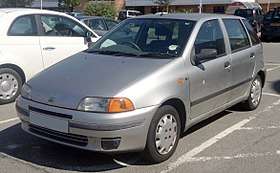 | |
| Overview | |
| Production | 1993–1999 |
| Assembly |
Melfi, Potenza, Italy Mirafiori, Torino, Italy Termini Imerese, Palermo, Italy Tychy, Poland[4] |
| Designer |
Giorgetto Giugiaro (hatchback) Bertone (convertible)[5] |
| Body and chassis | |
| Body style |
3-door hatchback 5-door hatchback 2-door convertible 3-door van |
| Related |
Fiat Barchetta Fiat Albea Fiat Doblò Fiat Palio Fiat Siena Fiat Strada Lancia Y |
| Powertrain | |
| Engine |
1.1 L I4 (petrol) 1.2 L I4 (petrol) 1.2 L I4 16-valve (petrol) 1.4 L I4 turbo (petrol) 1.6 L I4 (petrol) 1.7 L I4 (diesel) 1.7 L I4 (turbo-diesel) |
| Transmission |
5-speed manual 6-speed manual CVT automatic |
| Dimensions | |
| Wheelbase | 2,450 mm (96.5 in) |
| Length | 3,760 mm (148.0 in) |
| Width | 1,625 mm (64.0 in) |
| Height | 1,450 mm (57.1 in) |
| Curb weight |
830–1,040 kg (1,830–2,290 lb) 1,070 kg (2,360 lb) (cabrio) |
.jpg)

Internally codenamed Project 176, the Punto was announced in September 1993 as a replacement for the ageing Fiat Uno and launched in the end of 1993 or the beginning of 1994, depending on the market. The Fiat Punto was voted European Car of the Year for 1995,[6] defeating rival Volkswagen Polo by only 78 points.
The official launch of the Punto in the United Kingdom was in October 1993, at the London Motorfair.[7]
The Punto was designed by Giorgetto Giugiaro and was available as a three-door or five door hatchback, a two-door cabriolet and a three-door panel van.[8] As the majority of the new Fiat group models, suspension was all independent, composed of MacPherson struts at the front and trailing arms at the rear.
Entry level in the Punto range were the 1.1 and 1.2 L petrol engines and the 1.7 diesel engine. The 1.2 engine's actual capacity is 1242 cc, available in three versions. The first, was fitted in the Punto ELX 75 and produced 75 hp (56 kW) at 6000 rpm while the second, fitted to Punto ELX 85 produced 86 hp (64 kW) at 6000 rpm.
The third was a 60 hp (45 kW) engine which eventually replaced the 1.1 54 hp (40 kW) engine.

Sporting versions
A Sporting model was also available with a 1.6 8v updated 128 SOHC engine, producing 88 hp (66 kW), later replaced in 1997 by the 1.2 16v FIRE engine used in the 85 ELX, and a power drop to 86 hp (64 kW).
GT versions
The top of the range model was the 136 PS (100 kW; 134 hp) 1.4 GT, using an evolution of the turbocharged 128 SOHC engine originally found in the Fiat Uno Turbo Mk II - capable of running over 200 km/h (120 mph) and reaching 100 km/h (62 mph) in 7.9 seconds and came fitted with a five speed manual gearbox. During the years the GT was made in three different "series" with power 136 PS (100 kW; 134 hp) (1993–1995),133 PS (98 kW; 131 hp) (1995–1997) and 130 PS (96 kW; 130 hp) (1997–1999).[9]
Convertible
A cabriolet (convertible) version was also available; built by Bertone (rather than at the main Fiat factory), it featured an electric powered fully retracting roof and was one of the cheapest open top cars in the world at the time. In Europe, it was also made with a manual roof. Available in both ELX and SX trim, initially powered by the 90 hp (67 kW) 1.6 Mpi unit (replaced in 1995 by the 86 hp (64 kW) 1.2-L 16v FIRE unit). Approximately 55,000 cars were built between 1994 and 1999, although the last cars were registered in 2000.
Other versions
Particular versions of the first generation Punto were the Punto 6Speed, a 1.1 FIRE Punto 55 with a six speed gearbox, the Punto Selecta with a CVT type automatic gearbox, and the Punto ED (Economical Drive), a 1.1 Punto whose five speed gearbox was designed for high fuel efficiency.
Engines
| Code | Displacement | Type | Power | Torque | Compression |
|---|---|---|---|---|---|
| 1.1 SPI | 1,108 cc | I4 | 54 PS (40 kW; 54 hp) at 5500 rpm | 86 N·m (63 lb·ft) at 3250 rpm | 9.6:1 |
| 1.2 SPI | 1,242 cc | I4 | 60 PS (44 kW; 59 hp) at 5500 rpm | 98 N·m (72 lb·ft) at 3000 rpm | 9.6:1 |
| 1.2 MPI | 1,242 cc | I4 | 73 PS (54 kW; 72 hp) at 5000 rpm | 106 N·m (78 lb·ft) at 4000 rpm | 9.8:1 |
| 1.2 16v | 1,242 cc | I4 | 86 PS (63 kW; 84 hp) at 6000 rpm | 113 N·m (83 lb·ft) at 4500 rpm | 10.2:1 |
| 1.4 Turbo | 1,372 cc | I4 | 133-136 PS (98-100 kW; 131-134 hp) at 5750 rpm | 208 N·m (153 lb·ft) at 3000 rpm | 7.9:1 |
| 1.4 Turbo | 1,372 cc | I4 | 131 PS (96 kW; 129 hp) at 5600 rpm | 200 N·m (148 lb·ft) at 3000 rpm | 9.0:1 |
| 1.6 MPI | 1,581 cc | I4 | 90 PS (66 kW; 89 hp) at 5750 rpm | 129 N·m (95 lb·ft) at 2750 rpm | 9.5:1 |
| 1.7 Diesel | 1,698 cc | I4 | 57 PS (42 kW; 56 hp) at 4500 rpm | 98 N·m (72 lb·ft) at 2500 rpm | 19:1 |
| 1.7 Diesel | 1,698 cc | I4 | 64 PS (46 kW; 63 hp) at 4500 rpm | 118 N·m (87 lb·ft) at 2500 rpm | 19:1 |
| 1.7 Diesel | 1,698 cc | I4 | 72 PS (53 kW; 71 hp) at 4500 rpm | 137 N·m (101 lb·ft) at 2500 rpm | 19:1 |
Second generation (1999–2010)
| Second generation (188) | |
|---|---|
 | |
| Overview | |
| Also called |
Fiat Punto Classic Zastava 10 |
| Production |
1999–2010 (Italy)[10] 2005–2008 (Serbia)[11] |
| Assembly |
Melfi, Potenza, Italy Mirafiori, Torino, Italy Termini Imerese, Palermo, Italy Kragujevac, Serbia (Zastava) |
| Body and chassis | |
| Body style |
3-door hatchback 5-door hatchback 3-door van |
| Related |
Fiat Idea Lancia Ypsilon Lancia Musa |
| Powertrain | |
| Engine |
1.2 L I4 (petrol) 1.2 L I4 16-valve (petrol) 1.4 L I4 16-valve (petrol) 1.8 L I4 16-valve (petrol) 1.3 L I4 MultiJet (diesel) 1.9 L I4 DS (diesel) 1.9 L I4 JTD (diesel) |
| Transmission |
5-speed manual 6-speed manual (Sporting) 5-speed semi-automatic (Dualogic) 6-speed semi-automatic (Speedgear)[12] 7-speed semi-automatic (Speedgear)[12] |
| Dimensions | |
| Wheelbase | 2,460 mm (96.9 in) |
| Length |
3,800 mm (149.6 in) (3-door, 1999–03) 3,835 mm (151.0 in) (5-door, 1999–03) 3,840 mm (151.2 in) (3-door, 2003–10) 3,865 mm (152.2 in) (5-door, 2003–10) |
| Width | 1,660 mm (65.4 in) |
| Height | 1,480 mm (58.3 in) |
| Curb weight | 860–1,050 kg (1,900–2,310 lb) |
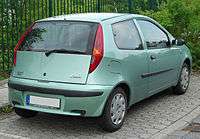

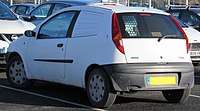
The second generation Punto, codenamed Project 188, was launched in September 1999 at the Frankfurt Motor Show. The styling was all new while retaining the original Punto's distinctive shape and design, while the chassis and interior were completely overhauled, with a new torsion beam rear suspension.
The new Punto also became the first Fiat in decades to carry the original round Fiat badge, to celebrate Fiat's centenary.
At the launch event of the hatchback, the Fiat Wish concept car was also presented, which was hardtop convertible version of the Fiat Punto, very similar in styling with the Peugeot 206 CC.[13] The model was conceived by Pininfarina to celebrate the centenary of Fiat.[14][15]
Entry level
The 1.1 and 1.4 turbo engines were discontinued due to emissions issues and the entry level models had only a 1.2 petrol unit, with either 8 or 16 valves, giving 60 hp (45 kW) and 80 hp (60 kW) respectively, or a 1.9L diesel, with common rail injection and turbocharger or naturally aspired with mechanical injection.[16]
Sporting versions

Two sporty versions were offered. The 1.2 16 valve Sporting model with a six-speed manual, and the 1.8 HGT which could reach almost 130 mph (210 km/h). The 1.2 16V model also has a Speedgear CVT equipped variant (with a sequential manual shift mode consisting of six gears, seven for the Sporting model).
The 1.8 HGT accelerates from 0 to 60 in 8.0 seconds. It was considered a big improvement in handling over the Punto GT. The HGT was also available (in limited numbers) as an "HGT Abarth" which added deeper bumpers, rear spoiler, side skirts, new alloy wheels and interior trim. The HGT Abarth had no technical improvements over the regular HGT.
Power steering
The second generation Punto has also adopted the Dualdrive electric power steering and came with two operation modes, using an electric motor, rather than a hydraulic pump driven by the engine.
This resulted in reduced fuel consumption and less environmental impact. It has a fuel economy of 5.6 l/100 km (50 mpg‑imp; 42 mpg‑US), urban and 3.9 l/100 km (72 mpg‑imp; 60 mpg‑US), extra urban for the 1.9 diesel. The 1.8 petrol does 8.8 l/100 km (32 mpg‑imp; 27 mpg‑US), urban and 5.3 l/100 km (53 mpg‑imp; 44 mpg‑US), extra urban.
Facelift
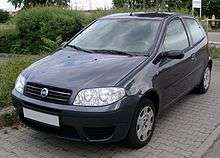
At the beginning of 2003, Fiat celebrated the rollout of the 5,000,000th production Punto. During the same year, the second generation facelift brought further revisions to the platform, including extensive changes to the exterior styling and engines, partly due to changes in pedestrian safety regulations.
The round Fiat badge, found only on the bonnet of second generation models, was introduced on the tailgate of the second generation facelift. On 1 June 2005, Fiat produced the 6,000,000th Punto at the Melfi plant.[17]
Engine changes included a new 1.4 L 16v engine, alongside the staple 1.2 and 1.2 L 16v variants, and the introduction of two HGT versions, the 1.9 L MultiJet diesel engine and the 1.8 L 16v petrol engine, which could reach almost 130 mph (210 km/h) continued over from the pre-facelift version. There was an introduction also of the 1.3 L common rail diesel MultiJet engine.
Punto Classic
Despite the launch of the slightly larger Grande Punto at the end of 2005, the second generation Punto remained in production, marketed as the Punto Classic, and has been sold in many emerging markets in addition to the newer versions. It was launched for the first time in Chile in 2007.[18] It ended production in Italy in November 2010.[19]
Zastava 10
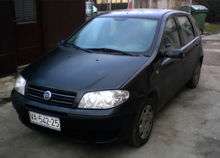
In October 2005, Serbian automotive manufacturer Zastava reached an agreement with Fiat to assemble this version under licence in Kragujevac, Serbia, with the model name Zastava 10. After acquiring a majority stake in Zastava in the autumn of 2008, Fiat continued production of this vehicle under the Fiat Punto Classic name from March 2009.[20]
Production was stopped in middle of 2011,[21] and it got restarted in 2013 albeit very briefly.[22] It has been available with the 1.2 litre petrol engine and later,[11] also with the 1.3 litre diesel engine, the 2013 version featured a newer, more modern engine.[23]
Trim levels
The Punto was initially released in four different trim leveles: S, SX, ELX and HLX,[24] that were later renamed to Actual, Active, Dynamic and Emotion. Three special versions of the three door hatchback were also available: Sporting, HGT and Abarth. The 'Sporting' had a six-speed manual gearbox as standard.
The top level included such features as ABS, front and side airbags, window bags, remote central locking, front power windows, electrical power steering, air conditioning, trip computer with four functions, CD player, CD changer, alloy rims and fog lamps. Options such as navigation and burglar alarm were also offered.[16]
After the facelift, it also received EBD, ESP with ASR and hill holder, climate control with double zone heating, MP3 player and subwoofer (HGT only), rear parking sensors and cruise control as an option.[25] A revised instrument panel with a larger display could now show the instant consumption too.[26]
Engines
Four petrol engines with multi point injection system were available, as well as one indirect injection diesel and three common rail turbocharged diesel engines with intercooler (JTD and MultiJet). The 1.8 16v and the 1.9 MultiJet engines were available only with the three door version in the HGT trim level.[16]
| Engine | Displacement | Power | Torque | Top speed | 0–100 km/h | Combined consumption | CO2 emissions | Production years | ||
|---|---|---|---|---|---|---|---|---|---|---|
| Petrol engines | ||||||||||
| 1.2-L 8v | 1,242 cc | 44 kW (60 PS; 59 hp) at 5000 rpm | 102 N⋅m (75 lb⋅ft) at 2500 rpm | 155 km/h (96 mph) | 14.3 s | 5.7 l/100 km (50 mpg‑imp) | 136 g/km | 09/1999– 01/2010 | ||
| 1.2-L 16v | 1,242 cc | 59 kW (80 PS; 79 hp) at 5000 rpm | 114 N⋅m (84 lb⋅ft) at 4000 rpm | 172 km/h (107 mph) | 11.4 s | 6.0 l/100 km (47 mpg‑imp) | 142 g/km | 09/1999– 01/2006 | ||
| 1.4-L 16v | 1,368 cc | 70 kW (95 PS; 94 hp) at 5800 rpm | 128 N⋅m (94 lb⋅ft) at 4500 rpm | 178 km/h (111 mph) | 9.9 s | 6.1 l/100 km (46 mpg‑imp) | 145 g/km | 06/2003– 01/2006 | ||
| 1.8-L 16v | 1,747 cc | 96 kW (131 PS; 129 hp) at 6300 rpm | 164 N⋅m (121 lb⋅ft) at 4300 rpm | 205 km/h (127 mph) | 8.6 s | 8.3 l/100 km (34 mpg‑imp) | 197 g/km | 09/1999– 01/2006 | ||
| Diesel engines | ||||||||||
| 1.3-L MultiJet 16v | 1,251 cc | 51 kW (69 PS; 68 hp) at 4000 rpm | 180 N⋅m (133 lb⋅ft) at 1750 rpm | 164 km/h (102 mph) | 13.4 s | 4.5 l/100 km (63 mpg‑imp) | 119 g/km | 06/2003– 01/2006 | ||
| 1.9-L D 8v | 1,910 cc | 44 kW (60 PS; 59 hp) at 4500 rpm | 118 N⋅m (87 lb⋅ft) at 2250 rpm | 155 km/h (96 mph) | 15.0 s | 5.7 l/100 km (50 mpg‑imp) | 150 g/km | 09/1999– 06/2003 | ||
| 1.9-L JTD 8v | 1,910 cc | 59 kW (80 PS; 79 hp) at 3000 rpm[nb 2] | 196 N⋅m (145 lb⋅ft) at 1500 rpm | 170 km/h (106 mph)[nb 3] | 12.2 s | 4.9 l/100 km (58 mpg‑imp) | 130 g/km | 09/1999– 01/2006 | ||
| 1.9-L JTD 8v | 1,910 cc | 63 kW (86 PS; 84 hp) at 3000 rpm[nb 4] | 200 N⋅m (148 lb⋅ft) at 1500 rpm | 173 km/h (107 mph)[nb 5] | 11.5 s | 4.9 l/100 km (58 mpg‑imp) | 130 g/km | 2002– 01/2006 | ||
| 1.9-L MultiJet 8v | 1,910 cc | 74 kW (101 PS; 99 hp) at 4000 rpm | 260 N⋅m (192 lb⋅ft) at 1750 rpm | 185 km/h (115 mph) | 9.6 s | 5.3 l/100 km (53 mpg‑imp) | 140 g/km | 06/2003– 01/2005 | ||
Third generation (2005–2018)
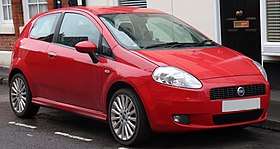
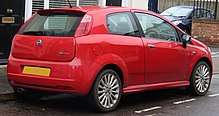
_%E2%80%93_Frontansicht%2C_3._Juli_2011%2C_Essen.jpg)

The Grande Punto, codenamed Project 199, was unveiled at the 2005 Frankfurt Motor Show and went on sale later on that year. Again styled by Giugiaro,[27] the car is based on the Fiat Small platform developed in joint venture with Opel-General Motors.
Punto Evo
In September 2009, the Grande Punto was facelifted, with the replacement known as the Punto Evo. It received a new front end in addition to revised rear lights, and a new interior.
Punto
In January 2012, the Punto name was brought back when the Punto Evo was facelifted and given a similar front end to the 2005 Grande Punto. The new Punto kept the revised rear lights and interior of the 2009 Punto Evo, but not on the base 'Pop' trim level which reverted to the older Grande Punto interior.
In October 2014, Top Gear Magazine placed the Punto Pop 1.2-L 8v 69 on its list of "The worst cars you can buy right now", describing the car as "An outclassed elderly supermini that kicks out 126 g/km yet takes 14.4 secs to wheeze to 62 mph, and it costs more than £10k."[28]
The Grande Punto in India went through a facelift changing the front face and a revised rear and giving it a more aggressive look and was named Punto Evo. This car also sports an SUV like ground clearance of 185mm for diesel and 195mm for petrol to suit Indian roads.[29] In October 2014, Fiat India released the Avventura, which was a crossover variant of the Punto Evo.[30]
Production of the Punto finally ended in August 2018, with no direct successor being announced.[31]
Punto Van
The Punto Van is a compact van designed for the commercial market. It features a petrol 1.2 8v engine, a petrol/CNG 1.2 8v engine and a diesel 1.3 MultiJet 16v engine.
Motorsport
The Punto has always been popular with amateur racing drivers due to its low cost and the wide availability of spare parts. Several competition and homologated versions of the Punto have been produced, such as the Punto Rally, the S1600 and the Punto Abarth.
A new rally car based on the third generation Punto, the Super 2000 Punto Abarth, was unveiled in 2005. It is four-wheel drive and powered by a 2.0 L 16 valve engine capable of producing 280 hp (210 kW). Also, a turbodiesel front wheel drive rally car has been produced, the Fiat Grande Punto R3D.
The Punto was the first diesel car to compete in the Targa Tasmania.
The Punto has won several rally championships, specifically:
- Italian Rally Championship (2003 and 2006)
- European Rally Championship (2006)
- 2006 International Rally Challenge season
A motorsport version of the car can be found in several liveries in the video games Colin McRae Rally 04, Colin McRae: DiRT, Sega Rally Revo and Gran Turismo 6.
Notes
References
- ↑ "Fiat Punto: sucesso no Brasil e no mundo". fiatpress.com. Retrieved 2 May 2013.
- ↑ "Fiat Punto 2012: the evolution of a best seller". fcapress.com.br. Retrieved 8 May 2013.
- ↑ Auto Edizione: Laatste Fiat Punto van de band, einde van een tijdperk | Auto Edizione, accessdate: 3. August 2018
- ↑ 10 million vehicles produced in the former FSM and Fiat Auto Poland factories
- ↑ Bertone, storia dei modelli Archived 8 February 2014 at the Wayback Machine.
- ↑ "Rewind to 1995: Fiat Punto". Quicks. Archived from the original on 17 January 2014. Retrieved 14 January 2014.
- ↑ "Motor Show 1993: Small cars are rapidly becoming big business: Efficient production boosts choice, writes Martin Derrick". www.independent.co.uk. 19 October 1993. Retrieved 10 October 2017.
- ↑ "Fiat Punto (1994 - 1999)". RAC. Retrieved 27 December 2012.
- ↑ "Punto GT". Puntopower.com. Archived from the original on 18 July 2011. Retrieved 16 August 2007.
- ↑ "Una Jeep per Mirafiori" (in Italian). Il Sole 24 Ore. 27 November 2010. Retrieved 7 July 2011.
Attualmente da Mirafiori escono Fiat Multipla, Punto Classic, Idea, Lancia Musa e Alfa Mito. Entro l'anno le prime due andranno fuori produzione [Currently from Mirafiori are rolling out Fiat Multipla, Punto Classic, Idea, Lancia Musa and Alfa Mito. By the end of the year the first two will go out of production]
- 1 2 "Kragujevac: Workers "expected more"". B92 News. 31 January 2009. Archived from the original on 6 January 2014. Retrieved 15 January 2012.
- 1 2 "Fiat Punto Speedgear" (PDF). The AA. 29 August 2000. Retrieved 5 January 2014.
Called Speedgear, they offer a whole raft of ratios – a veritable cog-fest – through an electronically controlled, continuously variable (CVT) system which, on demand, also doubles as a sequential manual gearbox. The new transmission is available in either the five-door ELX or the three-door Sporting; the former with six stepped ratios in the sequential manual mode, the latter with seven – these being closer spaced.
- ↑ "Prototipos Fiat Punto y versiones curiosas" (in Spanish). Club Fiat Punto. Archived from the original on 12 October 2011. Retrieved 5 January 2014.
- ↑ "Comunicato Stampa: Wish" (PDF) (in Italian). Pininfarina. 18 November 1999. Retrieved 5 January 2014.
- ↑ "Timeline" (PDF). Pininfarina. 19 July 2006. Retrieved 5 January 2014.
- 1 2 3 "Fiat Punto specifications". Auto-types.com. Retrieved 6 October 2012.
- ↑ "News". Italiaspeed.com. 2 June 2005. Retrieved 1 April 2012.
- ↑ "El Fiat Punto regresa a Chile" (in Spanish). Autocosmos.cl. 18 October 2007. Retrieved 7 July 2011.
- ↑ "Auto economiche nuove: Fiat Punto Classic fuori produzione" (in Italian). Auto e Motore. 24 February 2011. Retrieved 13 February 2014.
- ↑ http://www.italiaspeed.com/2009/cars/fiat/01/zastava/1601.html
- ↑ "::: ekapija - Fiat to restart Punto Classic production in 2013 :::". ekapija.com.
- ↑ "Punto Classic is Fiat鈥檚 secret weapon in Serbia - AutoEdizione.com". AutoEdizione.com.
- ↑ "Fiat Punto Classic". Fiat Automobile Serbia. Archived from the original on 31 January 2012. Retrieved 15 January 2012.
- ↑ "Fiat Punto Mk2 1999-2003 (Proyecto 188)" (in Spanish). Club Fiat Punto. Archived from the original on 12 October 2011. Retrieved 6 October 2012.
- ↑ "Catalogo Fiat Punto" (PDF) (in Italian). FiatPunto.com. Archived from the original (PDF) on 9 October 2003. Retrieved 6 October 2012.
- ↑ "Fiat Punto owner's manual". Fiat. Retrieved 6 October 2012.
- ↑ "Motor shows". Italiaspeed.com. Retrieved 5 August 2007.
- ↑ "The Worst Cars You Can Buy Right Now". Top Gear magazine. 9 October 2014. Retrieved 12 October 2014.
- ↑ "New Fiat Punto Evo Review, Test Drive". Autocar India. Retrieved 12 October 2014.
- ↑ "Fiat India launched Avventura at INR 5.99 Lakh". autocarhindi.com. Retrieved 11 November 2014.
- ↑ https://www.autocar.co.uk/car-news/new-cars/fiat-punto-taken-sale-after-13-years
External links
| Wikimedia Commons has media related to Fiat Punto. |
Zastava, road car timeline, 1955–2008 | |||||||||||||||||||||||||||||||||||||||||||||||||||||||
|---|---|---|---|---|---|---|---|---|---|---|---|---|---|---|---|---|---|---|---|---|---|---|---|---|---|---|---|---|---|---|---|---|---|---|---|---|---|---|---|---|---|---|---|---|---|---|---|---|---|---|---|---|---|---|---|
| Type | 1950s | 1960s | 1970s | 1980s | 1990s | 2000s | |||||||||||||||||||||||||||||||||||||||||||||||||
| 5 | 6 | 7 | 8 | 9 | 0 | 1 | 2 | 3 | 4 | 5 | 6 | 7 | 8 | 9 | 0 | 1 | 2 | 3 | 4 | 5 | 6 | 7 | 8 | 9 | 0 | 1 | 2 | 3 | 4 | 5 | 6 | 7 | 8 | 9 | 0 | 1 | 2 | 3 | 4 | 5 | 6 | 7 | 8 | 9 | 0 | 1 | 2 | 3 | 4 | 5 | 6 | 7 | 8 | ||
| City car | 600 | ||||||||||||||||||||||||||||||||||||||||||||||||||||||
| 750 | |||||||||||||||||||||||||||||||||||||||||||||||||||||||
| 850 | |||||||||||||||||||||||||||||||||||||||||||||||||||||||
| Subcompact | Yugo/Koral | ||||||||||||||||||||||||||||||||||||||||||||||||||||||
| 10 | |||||||||||||||||||||||||||||||||||||||||||||||||||||||
| Compact | Skala | ||||||||||||||||||||||||||||||||||||||||||||||||||||||
| 128 | Florida | ||||||||||||||||||||||||||||||||||||||||||||||||||||||
| Large family car | 1300/1500 | ||||||||||||||||||||||||||||||||||||||||||||||||||||||
| LCV | Rival | ||||||||||||||||||||||||||||||||||||||||||||||||||||||